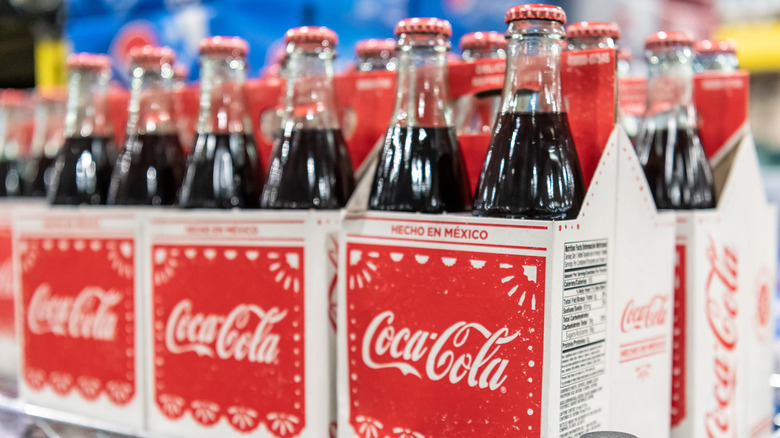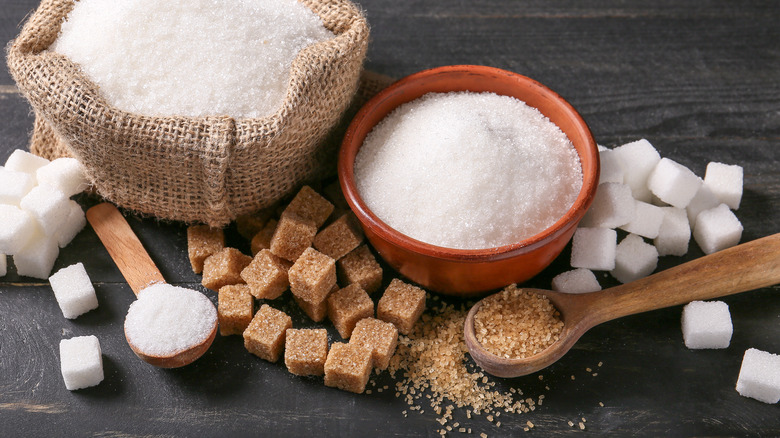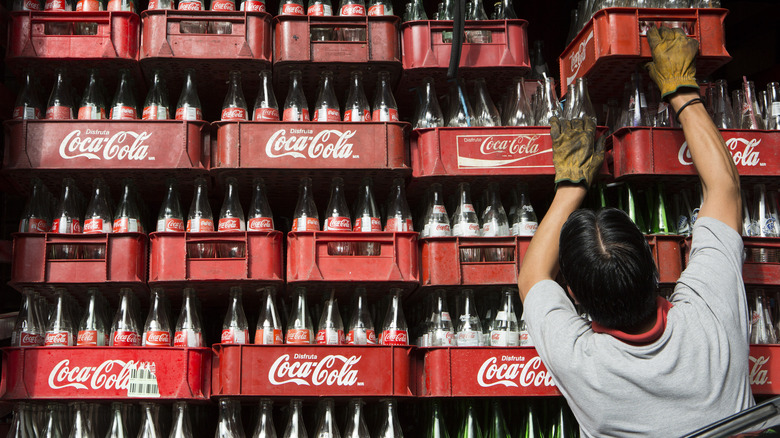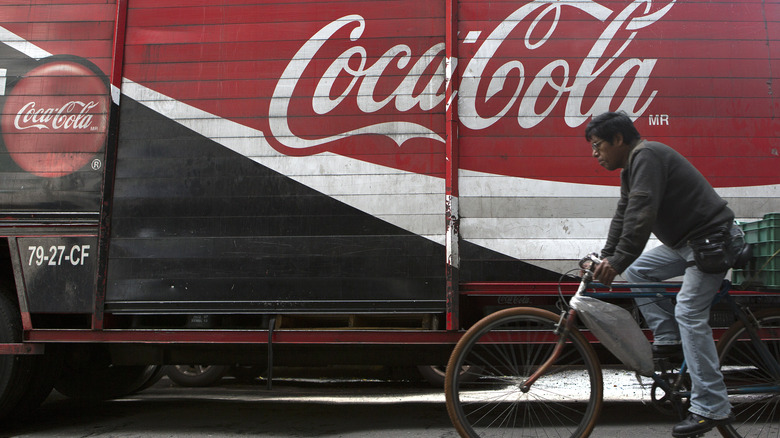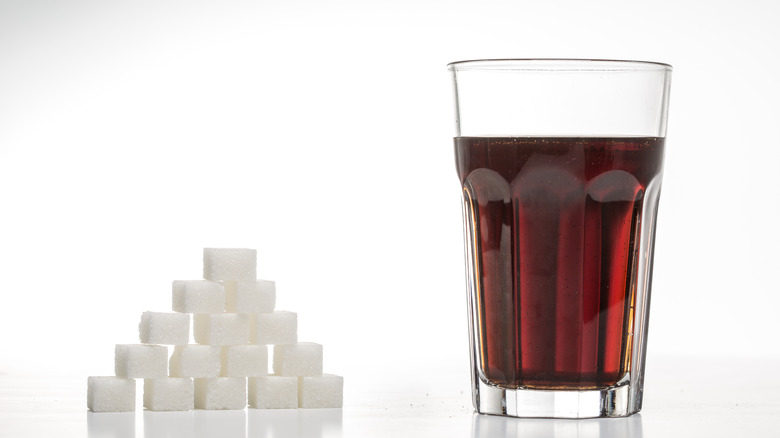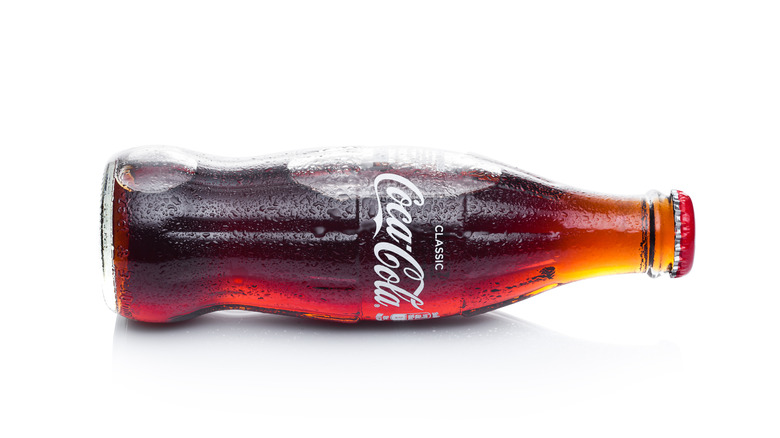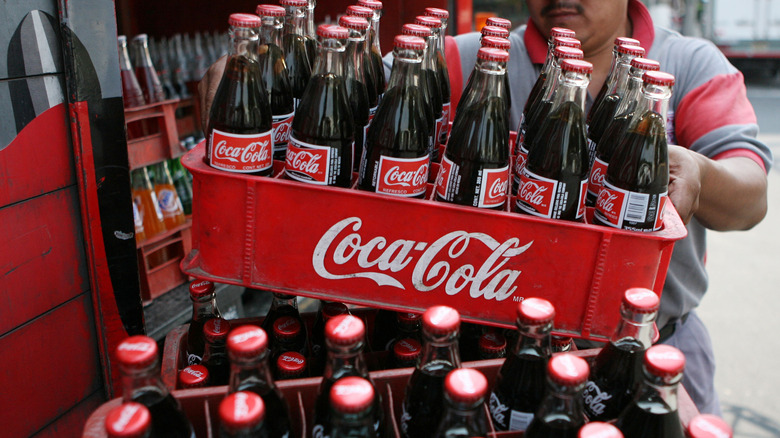The Untold Truth Of Mexican Coke
The sweet flavor of Coca-Cola has been tantalizing American tongues for decades, carbonating our weekends and packaging our culture into bottles and cans as no other company has. In the past couple of decades, American consumers have been cracking open an alternative version of the soft drink: the Mexican Coke.
In the soda aisle of most grocery stores these days, next to the cans and plastic two-liter bottles of traditional Coca-Cola, you'll find a selection of long-necked glass bottles of Coke emblazoned with the words Refresco, Hecho en México, and No Retornable. These bottles have been imported from Mexican Coca-Cola bottling plants to satiate your thirst for the extremely hyped version of the soda that has grown in popularity since 2005, when it was first officially sold in the United States (via DNA Info, New York Times).
Beneath the hype, what's really going on with Mexican Coke? With so many myths and layers of information about how it differs from traditional Coke and how it affects the Mexican communities where it's bottled, there's a lot bubbling inside the glass bottle.
It's all about the sugar
The difference between a Mexican Coke and its traditional counterpart is visually apparent on the bottle, but it's not just the packaging that distinguishes the two. While they are both made with the classic Coca-Cola formula, there's a vital difference in the ingredients list.
The core recipe of carbonated water, a sweetener, caramel color, caffeine, and the secret natural flavor ingredients is the same in both cases. The sweetener is where the recipes diverge. Traditional Coke is made with high fructose corn syrup. In Mexico, this is swapped out for cane sugar. There also may be a slight difference in the formula, as the Coke secret ingredients are slightly different in other countries, but this difference is rarely disclosed by the company (via Serious Eats).
Many consumers claim that the Mexican version made with real cane sugar is tastier. This is possibly due to a slightly less intense sweetness; some studies claim high fructose corn syrup is up to 1.5 times sweeter than plain old sugar, according to Live Science. Others believe soda sweetened with real cane sugar is more natural, pure, less harsh, and possibly healthier (via New York Times Magazine). Only, Coca-Cola wouldn't agree with those takes. "There is no perceptible taste difference ... Whether sweetened with high fructose corn syrup or sugar, a Coke is a Coke and both are 'the real thing,'" a representative from Coca-Cola told Consumerist.
Everyone thinks they prefer Mexican Coke
But do they really? Everyone seems to have their own (very strong) opinion on which version of the soda they prefer. More and more people swear by Mexican Coke and refuse to drink the American-made stuff, or are at least willing to splurge on the typically higher-priced sugar-sweetened soda. However, taste tests show varying results as to whether the perceived difference between the soft drinks has anything to do with flavor.
James Beard Award winner J. Kenji López-Alt once carried out a taste test with friends which suggested that the vast majority of them (seven of eight) chose the taste and aroma of American Coke over its Mexican counterpart (via Serious Eats). López-Alt carried out his test with precision and knowledge of scientific controls and biases and believes his study shows there is a perceivable taste difference between the two types of Coke. He also conducted a test that showed people who believed they liked Mexican Coke would usually pick Mexican Coke as their preferred type regardless of taste.
A similar taste experiment was conducted at Refinery 29 with a different method and different results. They found that the likelihood of someone favoring one or the other by taste alone was practically negligible. From their test, it seems that most people in their day-to-day life would not be able to accurately identify traditional or Mexican Coke by taste without seeing the package.
The Mexican Coke trade war
One reason for the discrepancy in ingredients is a simmering trade war between the United States and Mexico (via Smithsonian Magazine). The Mexican soda industry has always preferred sugar in its beverages because it aids the country's sugar industry.
In 1997, Mexico passed a tariff on high-fructose corn syrup to prop up the sugar industry because of the competition posed by corn syrup. The United States, which exports large amounts of corn syrup, did not take kindly to the tariff — they brought the case to the World Trade Organization, which ruled in favor of the U.S.
Five years later, Mexico tried again to make corn syrup prohibitively expensive. Again, the United States went to the WTO, and again, the WTO ruled in favor of the United States. Even after these legal setbacks, Mexico appears to be doing something right to keep high fructose corn syrup out of their soda industry, because Mexican Coke which is exported to the United States, continues to be made with cane sugar.
Is Mexican Coke healthier than traditional Coke?
One reason many Americans crave the cane sugar of Mexican Coke is that they believe it's healthier than the high fructose corn syrup used to sweeten classic American Coca-Cola.
Chemically, the two sweeteners both contain a combination of glucose and fructose and are broken down by your body in almost the same exact way. Culturally, high fructose corn syrup has been widely criticized and shunned in the US, leading many consumers to purchase foodstuffs made without it under the assumption that anything that doesn't have it on the ingredient list is more natural. The syrup is labeled as chemical, unhealthy, and toxic in the minds of many consumers, which is even leading a rebrand as corn sugar (via Live Science).
The widespread bias against corn syrup is not based in fact. Leading health writer and columnist at the New York Times, Jane Brody, asserts that there is no scientific reason high fructose corn syrup is more unhealthy than any other sweetener, with similar calories per gram and chemical composition across the board. "It's an urban myth that high-fructose corn syrup has a special toxicity," Michael Jacobson, of the Center for Science in the Public Interest, told the New York Times. Jacobson believes if sugar was used instead of corn syrup in all of our food, there would be no difference in national health.
So while Mexican Coke is not actually healthier than Coke, the consumer's perception against corn syrup will continue to inform their soda choices.
The curvaceous glass Coke bottle
Another reason people reach for Mexican Coke is the appealing glass bottle, which is nostalgic and aesthetic. Drinking ice-cold soda out of the classic bottle creates an undeniable experience that elevates the taste and feel of the drink.
The classic bottle shape as we know it was not the original design. According to The Coca-Cola Company, the contoured bottle design was created in 1915 after typical bottle shapes were mimicked by other soft drink producers. Hoping to create a long-lasting national brand identity that consumers would connect with for years to come, the company asked for a bottle design that would be "so distinct that you would recognize if by feel in the dark or lying broken on the ground." The winning design copied the elongated shape and ribbed texture of a cocoa bean. The bottle was trademarked in 1961 — an unusual move for product packaging, but one that made sense for the distinct bottle.
The bottle is now called the "contour bottle" after a 1925 French magazine article that used the phrase. The glass bottle is not used for classic American Coke as often, as cans and plastic bottles have become the norm. A very similar shape is still used by Mexican bottling plants, and so it lives on in every case of Mexican Coke, per Refinery29. Undoubtedly, the flair of the glass contour bottle adds to the appeal of Mexican Coke for many American consumers.
The politics of Mexican Coke
Just as Coca-Cola has had a huge impact on American life, it has also greatly affected Mexican culture and politics. The delicious Mexican Coke so many Americans enjoy has had far-reaching effects on the country.
The Coca-Cola company marketed very strongly in the country starting in the 1970s by putting out national advertisements, sponsoring large sporting events like the Mexico City Olympics, and incentivizing small business owners to exclusively sell Coke. The popularity of the soda skyrocketed and became cemented as a Mexican staple. Vicente Fox, formerly of Coca-Cola Mexico, was elected the president of the country in 2000. Protecting big business, especially Coca-Cola, informed many of his actions during his term (via Business Insider).
The New York Times reported on the way Coca-Cola bottling plants affect the communities they are located in, from using a ton of water that would otherwise be available to citizens to generating a unique following that uses Coke in medicine and religious practice. The Guardian explores the high soda consumption rates in Mexico and Coke's role in the country's obesity and diabetes struggles.
Of course, a huge corporation that infiltrates a national identity will have side effects. These effects are important to consider when reaching for a Mexican Coke.
